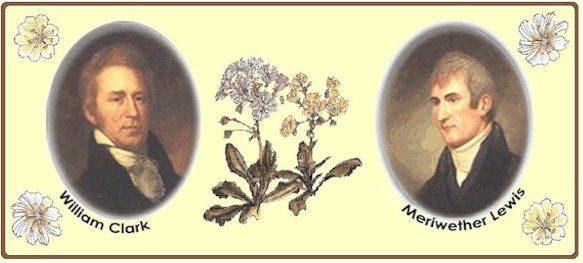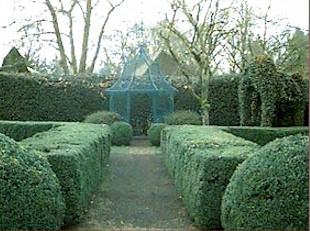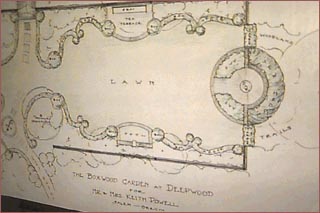WALLACE W HANSEN
Native Plants of the Northwest
Native Plant Nursery & Gardens
2158 Bower Ct S.E., Salem, Oregon 97301 E-Mail:
Wallace W Hansen
PHONE (503)581-2638 FAX(503)581-9957

WALLACE W HANSENNative Plants of the NorthwestNative Plant Nursery & Gardens2158 Bower Ct S.E., Salem, Oregon 97301 E-Mail:
Wallace W Hansen |

|
| Information about Wallace W Hansen Northwest Native Plant Nursery & Gardens: Business Information (Ordering, etc.) | |
Updated April 24, 2003 |
Wallace Hansen Celebrates Lewis and Clark |
|
|

 
|
Botanical Discoveries of the Lewis and Clark ExpeditionBerries: Salmonberry (Rubus spectabilis), Serviceberry (Amelanchier alnifolia), Thimbleberry (Rubus parviflorus)The Dalles in Wasco County, Oregon, April 15, 1806 Of the Thimbleberry, Lewis wrote this is a "shrub of which the natives eat the yung sprout without kooking." Earlier on April 8, he found both the Thimbleberry and the Salmonberry and noted the differences between the two. Because of his notes on April 8, it may be that he actually collected them on that day instead of the 15th as indicated in his journal. The Serviceberry, also known as Saskatoon, was collected either April 11 or 15. Again, there is mention in Captain Clark's journals of this berry on the 11th but the specimen is dated the 15th. At whatever date the specimens were collected, these three berries are as delicious today as they were in 1806. Fortunately for us, some things don't change! These Northwest Native shrubs are included at special low prices during our Spring Sale. |
(Click on image for large view) |
At this time in 1806:The Expedition prepares to give up their canoes and proceed over land. To this end, they are collecting provisions and horses. The Corps strikes a bargain after some parlay with the native peoples.
More visitors led by Yellept, Chief of the Wallawallas. This nation is friendly after urging by Yellept. As was the norm, the interaction between the native peoples and the Corps was very interesting.
Chief Yellept wanted the Corps to stay on for a few more days as he had invited the Chymnappos, a neighboring nation, to join them and see the Expedition members dance. Though they were anxious to be on their way, they wanted Yellept to loan them some canoes to cross the river. Yellept decided they could stay 2-3 more days to enjoy the dancing and would not allow the loan. He had the Corps where he wanted them. However, another bargain was struck, the canoes were loaned, the dancing was done, trades were performed and everyone was satisfied. Captain Clark deemed the Wallawallas to be "friendly, honest people." |
Current events: |
|
|
If
you're in the area of Columbia, Missouri, the first part of May, 2003,
don't miss this outstanding event!
Columbia, Missouri • May 2, 3 and 4, 2003 World
Premiere
Cast
and Action of
Corps of Discovery, A Musical Journey By Michael Ching and Hugh Moffatt Pamela Legendre, Artistic Director Commissioned by MU Show-Me Opera University of Missouri-Columbia Cast: Other
characters: ACT
I – Camp Dubois to Fort Mandan
(December 1803 to April 1805) ACT
II – Fort Mandan to the Pacific
(Summer to Christmas Day 1805) ACT
III – The Death of Lewis
(Oct. 11, 1809) For information on booking the three-act Show-Me Opera production or the 45-minute smaller stage version; for rental or purchase of orchestral score and parts; and for rental or purchase of piano/vocal score and other options, please contact:
The
Creative Team of Michael
Ching,
Composer Hugh
Moffatt,
Librettist Pamela
Legendre,
Artistic Director |
|
|
|
|
|
The Corps of Discovery II Lewis and Clark Traveling Exhibit Beginning it's 4-year tour, stopping at communities along the trail that the Corp of Discovery took during the three years and eight months it took to make their journey. The exhibit will end in Oregon. The exhibit consists of a 53-foot long trailer carrying two tents, a stage, chairs, lighting, sound and visual gear and heating and air-conditioning equipment. One tent will hold an audio tour of replicas of historical paintings depicting the expedition's main characters and the landscapes they saw. Guided and sponsored by the following organizations: Library Associations of Washington D.C., Virginia, West Virginia, Maryland, Pennsylvania, Ohio, Kentucky, Indiana, Illinois, Missouri, Iowa, Kansas, Nebraska, South Dakota, North Dakota, Montana, Idaho and Oregon - which collectively comprise Trail States Library Associations - and the U.S. National Park Service (NPS). |
|
|
|
|
|
Deepwood Estate Museum 1894 Queen Anne Style Home Salem, Oregon Landscape architects Elizabeth Lord and Edith Schryver were commissioned by Alice Brown to create the formal gardens at Deepwood Estate. Lord and Schryver were the first formally trained women landscape architects in the Northwest. Pictured at right, top, is the 1905 Lewis & Clark Gazebo acquired by Mrs. Brown and sited at Deepwood in 1949. Below is an architectural drawing of the grounds at Deepwood. Deepwood is the most significant example of landscape architects Elizabeth Lord and Edith Schryver's Northwest work. It is their only garden design that is open to the public. Intriguing features at Deepwood include a scroll garden with a hidden signature, an ivy tunnel and a pastel tea garden. There are three other superb examples of their designs in the area, but they are associated with private residences.
|

|
|
Visitor Information 1116 Mission Street SE Salem, Oregon 97302
Deepwood grounds open dawn to dusk daily at no charge. Deepwood House Tours are 12:00-5:00 pm. hourly, May thru September, Sunday-Friday; October thru April, Tuesday-Saturday Admission: Adults, $4.00/Students and Seniors, $3.00/Children, $2.00 (under six - free)
http://www.oregonlink.com/deepwood/ House Tour Information: 503-363-1825 |

|
|
|
|
|
PICTURING THE CORPS OF DISCOVERY: The Lewis and Clark Expedition in Oregon Art An exhibit at the State Capitol building Presented by Oregon Historical Society |
|
|
December
20, 2002 through December 2004
State Capital building, 900 Court Street NE, Salem, Oregon 8 a.m. - 5 p.m. Monday - Friday 12 p.m. - 4 p.m. Saturday Closed - Sunday |
|
|
"Picturing
the Corps of Discovery demonstrates how artistic interpretations of the
Lewis and Clark Expedition mirror the history and evolving values of
Americans, and more specifically Oregonians, over the past two centuries.
Viewers will be introduced to works of art with Lewis-and-Clark themes
that reflect changing understandings of topics as diverse as democratic
ideals, ethnicity, and the environment.
A collection of images of Lewis and Clark pointing westward, including Frank Schwarz's treasured 1938 mural in Oregon's Capitol rotunda, demonstrate how the two explorers were credited with introducing civilization to the West well into the first half of the twentieth century. By the end of the century, however, works like Michael Florin Dente's 1988 sculpture, The Naming of Mount Jefferson, at the University of Portland, celebrated the expedition's ethnic mix as a historical precedent for a multicultural, pluralistic society in the West." http://www.ohs.org/exhibits/picturing-the-corp-of-discovery.cfm |
|
|
|
|
Back Issues:To see back issues of Wallace Hansen Celebrates Lewis and Clark, click on this link to jump to the index. |
|
Commemorative Painting by Heidi Hansen:The illustrated map below was created by renowned botanical artist Heidi D. Hansen especially for this website. Done in ink and watercolors, Heidi shows many of the plants Captain Lewis documented overlaid atop a map showing a portion of the journey. (Click on image for large view). |
|
|
|
|
|
|
|
|
|
|
|
|
|
|
Click here to return to my Home Page |
|
Questions about plants, click here: Regular Email to Wally To order, click here: Secure Email to Wally |
|
|
Comments or questions about our web site, click here: Webmaster |